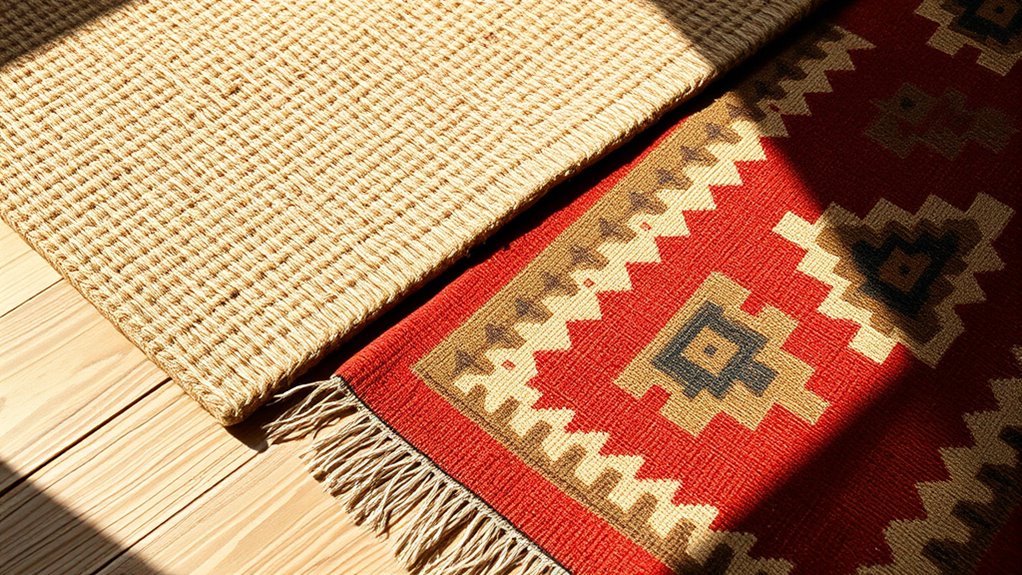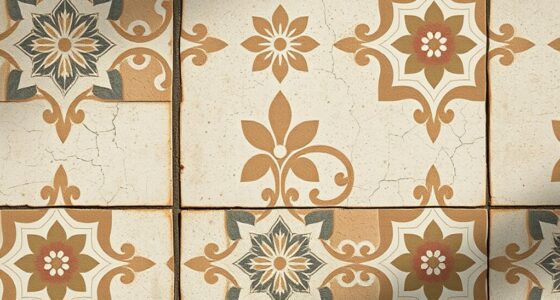Layering jute over kilims adds warmth, texture, and a cozy touch to your September floors. You can create a stylish, inviting space by selecting quality rugs in complementary colors and shapes, then arranging them for balance and comfort. Mixing sizes and shapes adds visual interest, while using rug pads keeps everything stable. Want to discover tips for styling, maintaining, and seasonal advantages? Keep exploring to make your layered rugs truly perfect.
Key Takeaways
- Layer jute and kilims to create warm, textured, and eco-friendly floors that add coziness and visual interest to September interiors.
- Choose appropriately sized and shaped rugs, mixing textures and patterns for balanced, stylish layered arrangements.
- Use rug pads or non-slip mats to prevent slipping and protect flooring beneath layered jute and kilim rugs.
- Coordinate colors and patterns for harmony, blending neutral tones with bold accents to suit seasonal decor.
- Maintain rugs regularly with gentle vacuuming, spot cleaning, and proper rotation to keep layers looking fresh and inviting.
Understanding the Charm of Jute and Kilims
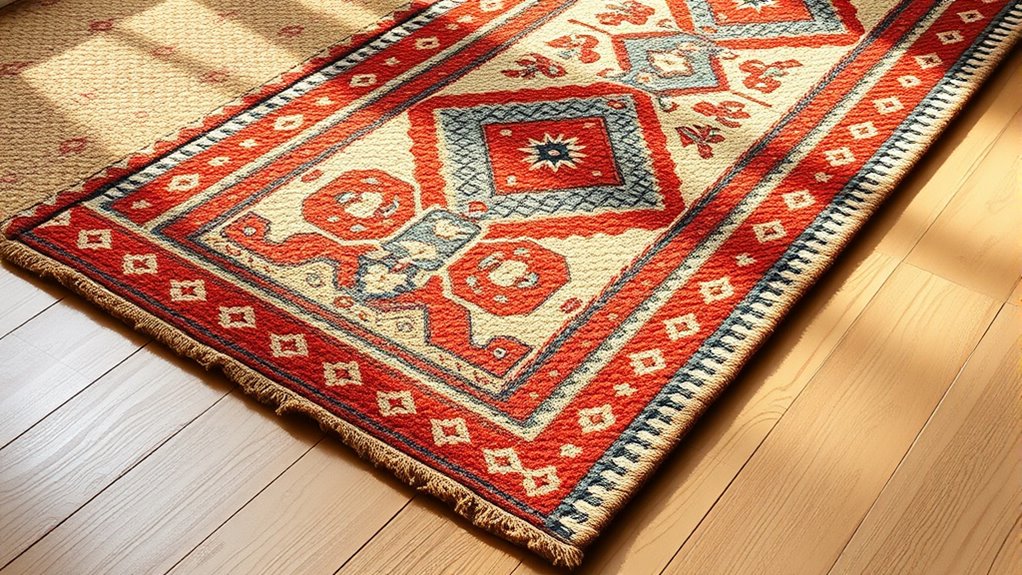
Jute and kilims bring a natural, earthy appeal to layered rugs that instantly enhance any space. You’ll notice how their textures add warmth and character, creating a cozy, inviting atmosphere. You may also consider incorporating natural materials like wood and linen to further emphasize authenticity and rustic charm. Jute’s coarse, fibrous surface offers a rustic charm that pairs well with softer textiles, while kilims introduce vibrant colors and geometric patterns that add visual interest. Together, they strike a perfect balance of simplicity and artistry, making your floor a focal point. The organic tones of jute complement the bold hues of kilims, giving your room an authentic, handcrafted feel. This combination isn’t just stylish—it’s also eco-friendly, sustainable, and durable, making it an excellent choice for those who want a natural, timeless look. Using layered rugs with diverse textures can also help define different areas within an open-plan space. Additionally, the rise of sustainable interior design emphasizes the importance of choosing eco-conscious materials like jute and kilims to create environmentally friendly homes. Layering jute and kilims transforms your space into a warm, textured haven.
Choosing the Perfect Jute Rug for Your Space

When selecting a jute rug, pay close attention to material quality to guarantee durability and softness. Consider the size and shape that will best fit your space without overwhelming or underwhelming the room. Finally, choose a style and color that complements your existing decor, creating a cohesive layered look. Incorporating symbol recognition can also help you identify meaningful patterns that enhance your overall design.
Material Quality Matters
Since the quality of materials directly impacts the durability and appearance of your rug, choosing a high-quality jute rug guarantees your investment will last. Look for tightly woven fibers that feel sturdy underfoot and resist fraying. A good jute rug should have even coloration without visible imperfections or thin spots. Avoid rugs with loose threads or uneven texture, as these indicate lower quality. Natural jute fibers should feel coarse but not abrasive, ensuring comfort without sacrificing strength. Higher-grade jute often comes from reputable sources, offering better dye retention and fewer contaminants. Investing in quality guarantees your rug maintains its aesthetic appeal over time and withstands daily wear. Additionally, material quality plays a crucial role in ensuring your layered rug setup remains beautiful and functional for years to come.
Size and Shape Choices
Choosing the right size and shape of your jute rug is essential to creating a balanced and inviting space. Measure your room carefully, considering furniture placement and traffic flow. A large rug can anchor a living room, making the space feel cohesive, while smaller rugs work well in cozy corners or entryways. Rectangular shapes are versatile and suit most rooms, but don’t overlook round or oval options to add visual interest. If you have an open-plan area, layering smaller rugs can define different zones. Keep in mind that your rug should complement the room’s proportions; it shouldn’t overpower or get lost. Selecting the appropriate size and shape ensures your layered rug setup feels intentional, comfortable, and harmonious within your space. Proper sizing and shape are crucial for establishing a balanced aesthetic and functional layout, especially when considering diverse room configurations to enhance your home decor. Additionally, choosing the right rug material can affect the overall coziness and durability of your layered setup. Incorporating appropriate contrast between rugs and the surrounding flooring can further elevate your layered design. Paying attention to space optimization can help you create a more functional and inviting environment.
Style and Color Coordination
Selecting the right style and color for your jute rug can instantly enhance your space’s overall aesthetic. To create harmony, consider these tips:
- Match your rug’s color with existing decor to unify your space.
- Use neutral tones for versatility and a calming effect.
- Incorporate bold colors for a statement piece that energizes the room.
- Opt for patterns or textures that complement your furniture style—modern, rustic, or eclectic.
- Consider the durability and maintenance requirements of different rug materials to ensure long-term satisfaction home furnishings.
- Be mindful of how emotional manipulation or unresolved conflicts in a space can influence your overall well-being and sense of peace narcissistic behavior.
- When selecting your rug, also think about electric power generation with bike generators to promote a sustainable and eco-friendly home environment.
- Additionally, choosing a rug with proper fiber quality can help maintain its appearance and longevity over time.
Selecting an Ideal Kilim for Layering
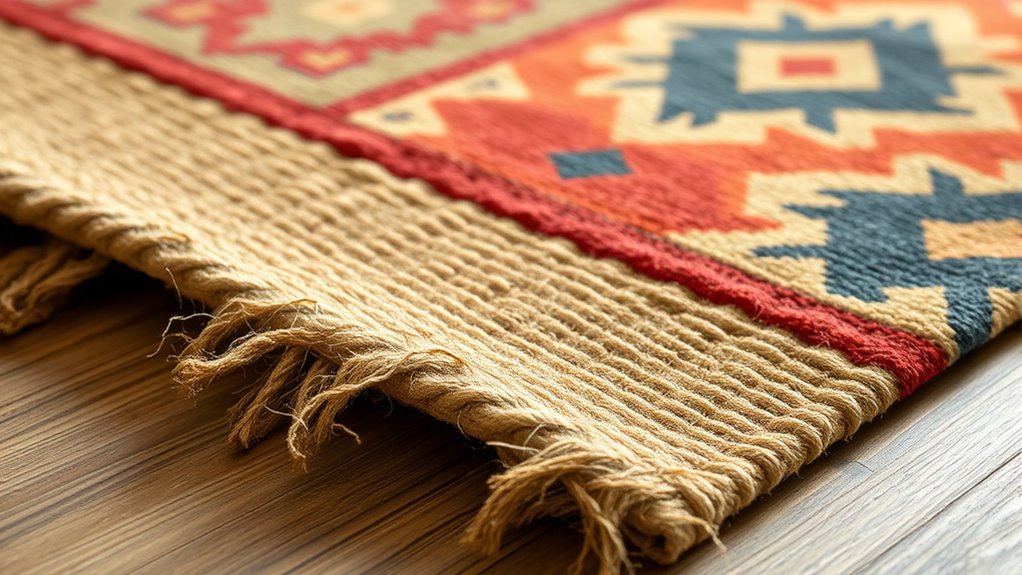
When layering a kilim with other rugs, picking the right one can transform your space. You want a kilim that complements your existing decor while adding texture. Choose a kilim with a pattern and color palette that contrasts but doesn’t clash with your jute rug. Opt for a kilim with a flat weave and durable fibers to withstand foot traffic. Consider size: a smaller kilim works well as an accent, while a larger one can anchor the room. Balance is key—avoid overwhelming the space with busy patterns or loud colors. Here’s a quick guide:
| Pattern Type | Color Palette | Size Recommendation |
|---|---|---|
| Geometric | Earth tones | Small to medium |
| Striped | Bright hues | Medium to large |
| Abstract | Neutral shades | Small to medium |
Choose wisely, and you’ll create a cozy, layered look. Additionally, selecting a kilim made from durable fibers ensures it maintains its appearance over time and can handle daily foot traffic effectively. Incorporating a kilim with a distinctive pattern can add visual interest and enhance the layered effect. To further enhance longevity, consider choosing a kilim with colorfast dyes, which helps prevent fading over time. Moreover, understanding the role of attention in creative practice can inspire you to carefully select and arrange your rugs for a harmonious aesthetic. Remember that visionary ideas often inspire innovative interior design choices, like mixing textures and patterns to create a welcoming atmosphere.
Tips for Creating a Balanced and Stylish Layering Effect
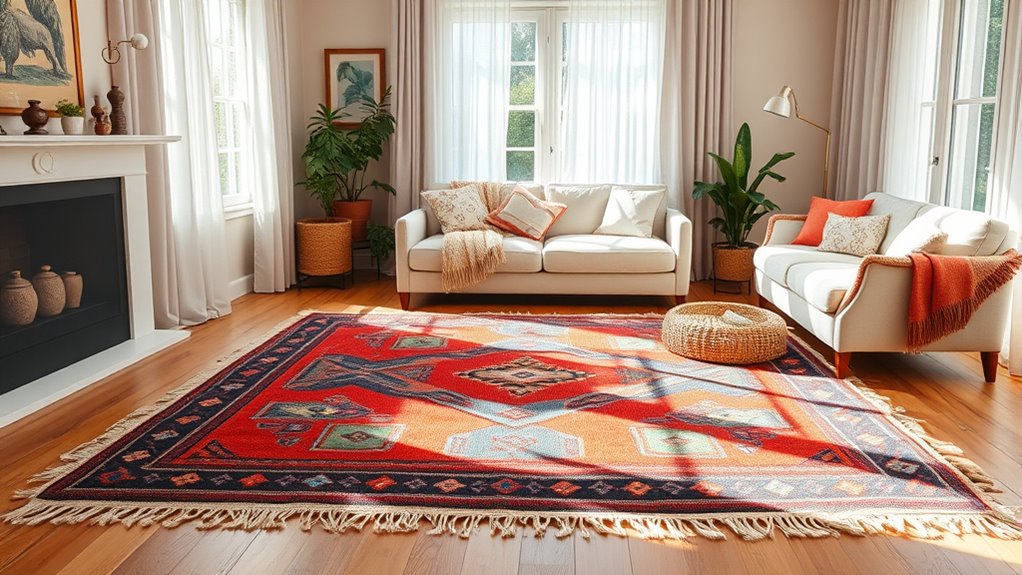
Creating a balanced and stylish layering effect starts with thoughtful arrangement and attention to scale. To achieve this, consider these tips:
- Make sure the larger rug, like your kilim, anchors the space, while smaller rugs, such as jute, add texture on top.
- Vary the textures and patterns to create visual interest without overwhelming the eye.
- Keep rugs aligned or slightly overlapping, but avoid excessive stacking that looks cluttered.
- Use rugs that complement each other’s colors, balancing bold hues with neutral tones for harmony.
- Understanding your personality traits can help you select the right textures and patterns that reflect your personal style.
Arranging Rugs for Optimal Comfort and Aesthetics
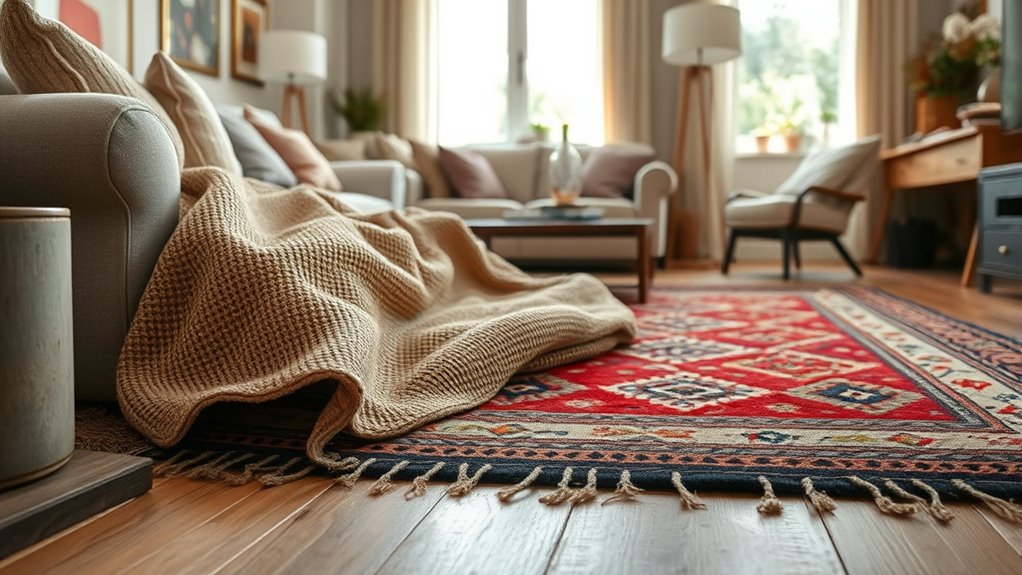
To guarantee your rugs enhance both comfort and style, start by carefully considering their placement in the space. Position your layered rugs so they anchor key areas, like under the dining table or in the living room’s seating zone. Make sure the main rug extends beyond furniture edges for a cozy feel and easy walking. The jute layer should be slightly larger or centered under the kilim, creating a balanced look. Keep walkways clear and avoid cluttering the space with too many layers, which can feel crowded. Use furniture placement to frame your rugs, ensuring they complement rather than overpower the room. Proper arrangement not only boosts comfort but also highlights the layered design’s visual appeal. Additionally, paying attention to the layering technique can help you achieve a cohesive and inviting aesthetic. Incorporating sustainable materials like jute can also enhance the eco-friendly aspect of your layered rug arrangement.
Incorporating Colors and Patterns for Visual Interest

Adding colors and patterns to your layered rugs instantly boosts visual interest and brings personality to your space. To achieve this, consider these ideas:
Layered rugs with vibrant colors and patterns instantly add personality and visual interest to any room.
- Mix solid and patterned rugs to create contrast and depth.
- Use rugs with complementary colors that tie into your room’s palette.
- Incorporate geometric or traditional patterns to add visual intrigue.
- Layer bold, vibrant kilims over neutral jutes to make statement areas.
Maintenance and Care for Layered Rugs

Maintaining layered rugs requires regular attention to keep them looking their best and prevent damage. You should vacuum both layers frequently, using a gentle setting to avoid fraying. Rotate the rugs every few months to prevent uneven wear and fading. Spot clean spills immediately with a damp cloth, avoiding harsh chemicals. For deeper cleaning, check care labels—most jute and kilim rugs benefit from professional cleaning once a year. Here’s a quick guide:
| Task | Tip |
|---|---|
| Vacuuming | Use gentle setting, avoid beater bars |
| Rotation | Rotate every 3-4 months |
| Spot Cleaning | Blot spills quickly, use mild soap |
| Deep Cleaning | Professional cleaning recommended |
| Avoid Moisture | Keep rugs dry to prevent mold |
Proper care extends the life and beauty of your layered rugs.
Seasonal Benefits of Jute and Kilim Combinations

Using jute and kilim rugs together can improve insulation, helping your home stay warmer in winter and cooler in summer. These natural fibers also regulate temperature effectively, making seasonal changes more comfortable. Plus, their eco-friendly qualities make them a sustainable choice year-round.
Enhanced Insulation Qualities
Because different rug materials offer unique insulating properties, combining jute and kilim layers can considerably boost your home’s warmth during colder months. Jute’s thick, fibrous texture traps air, serving as a natural insulator. Kilims, with their dense weaves, add an extra barrier against drafts. Together, they create a layered effect that improves heat retention.
Here’s how this combination enhances insulation:
- Air pockets in jute trap heat effectively.
- Kilim’s dense weave blocks cold drafts.
- Layering adds an extra thermal barrier.
- The materials work together to reduce heat loss, keeping your space warmer and more comfortable during chilly weather.
Natural Temperature Regulation
When temperatures fluctuate seasonally, combining jute and kilim layers helps your home adapt naturally to changing conditions. During colder months, jute’s dense fibers add warmth by trapping air, making your space cozier without extra heating. Meanwhile, kilims, with their intricate weaves, provide insulation and help retain heat. As temperatures rise, the natural breathability of jute allows heat and moisture to escape, preventing overheating and dampness. The layered combination creates a buffer that moderates temperature swings, keeping floors comfortable year-round. This synergy not only enhances comfort but also reduces reliance on heating and cooling systems, making your home more energy-efficient. By choosing these natural materials, you support a sustainable approach to seasonal comfort, ensuring your space remains inviting in every season.
Eco-Friendly Seasonal Choice
Opting for layered jute and kilim rugs offers an eco-friendly way to enjoy seasonal comfort. These natural materials minimize environmental impact while enhancing your home’s coziness. Jute is biodegradable, renewable, and requires minimal processing, making it a sustainable choice. Kilims, often crafted from organic wool or cotton, add insulation without synthetic chemicals. Combining them creates a breathable, moisture-wicking surface perfect for changing weather. Here are four benefits:
- Reduces reliance on synthetic, non-biodegradable rugs
- Supports eco-conscious craftsmanship and local artisans
- Enhances indoor air quality with natural fibers
- Provides versatile, stylish warmth for transitional seasons
Layering jute and kilim rugs helps you stay eco-friendly and cozy all season long.
Design Inspiration: Styling Ideas for Your Cozy Floors

Layered rugs instantly add warmth and personality to any space, transforming your floors into cozy, inviting areas. To style them effectively, start with a bold kilim as your base, then layer a textured jute rug on top for added depth. Mix patterns and colors that complement your room’s palette, creating visual interest without overwhelming the space. Place the rugs under key furniture pieces—like a sofa or dining table—to anchor your layout. You can also add small, decorative accents like poufs or baskets on the layered rugs for extra texture. Keep the layering simple and balanced to avoid clutter. This approach makes your room feel curated yet comfortable, perfect for September’s cozy vibe. Experiment with different textures and sizes to find what works best for your style.
Troubleshooting Common Layering Challenges

Layering rugs can be tricky when sizes don’t match or surfaces are slippery, causing safety issues and uneven looks. You might also struggle with coordinating colors so the layers don’t clash. Let’s explore simple solutions to these common challenges to help you create a cohesive, safe layered rug setup.
Mismatched Rug Sizes
When rug sizes don’t quite match, the layered look can become awkward or unbalanced. To fix this, consider these tips:
- Start small: Use a smaller rug over a larger one to create a clear focal point.
- Align edges: Slightly offset the edges for a casual, intentional vibe.
- Vary shapes: Mix rectangular, square, or round rugs to add visual interest.
- Adjust layers: Tuck edges under furniture or add a border to create clean lines.
These strategies help balance mismatched sizes, making your layered rug setup look intentional and stylish. Focus on creating harmony through subtle overlaps and varied shapes, rather than perfect symmetry. This approach ensures your layered rugs enhance your space without feeling mismatched or awkward.
Slippery Underneath Surfaces
Ever notice how rugs can shift or slide out of place underfoot? This common issue can make your layered setup feel unstable. To combat this, consider using rug pads or non-slip mats underneath your jute and kilim layers. These accessories create friction, helping your rugs stay put on slippery floors like hardwood or tile. Here’s a quick visual:
| Floor Type | Recommended Solution | Benefits |
|---|---|---|
| Hardwood | Non-slip rug pad | Prevents sliding, adds cushioning |
| Tile | Rubber-backed mats | Improves grip, protects surface |
| Vinyl | Double-sided tape | Keeps rugs secure, easy to remove |
| Laminate | Silicone rug pads | Prevents movement, reduces noise |
| Concrete | Rug grippers or tacks | Ensures stability on rough surfaces |
Choose the right solution to keep your layered rugs safe and steady.
Color Coordination Issues
Do you find that your layered rugs clash instead of complementing each other? Color coordination can be tricky, but a few tips help. First, choose a unifying color palette—stick to shades within the same family or complement each other. Second, balance bold patterns with solid hues to prevent visual chaos. Third, consider the room’s overall decor to ensure your rug colors tie in seamlessly. Fourth, test small swatches or rugs together before committing to the full layer. By following these steps, you create a harmonious look, making your layered rugs feel intentional and cozy. Remember, subtle contrasts often work better than stark differences, helping your space feel inviting rather than chaotic.
Frequently Asked Questions
How Do Layered Rugs Affect Indoor Air Quality?
Layered rugs can impact your indoor air quality, especially if they trap dust, pet dander, or allergens. You might notice more dust accumulation or allergies acting up. Regular vacuuming and cleaning help reduce these issues. Choosing natural, breathable materials like jute and kilims can also improve airflow and reduce airborne particles. Keep your space well-ventilated, and you’ll enjoy cozy floors without compromising your indoor air quality.
Can Layered Rugs Be Used Outdoors or in High-Humidity Areas?
Layered rugs are generally not suitable for outdoor or high-humidity areas because they can trap moisture, leading to mold and mildew growth. If you want to use layered rugs outside, choose materials specifically designed for weather resistance, like synthetic fibers. Otherwise, you risk damaging your rugs and reducing indoor air quality due to mold spores. Always prioritize durable, moisture-resistant options for outdoor or damp spaces.
Are Layered Rugs Suitable for Homes With Pets or Children?
Let’s look at layered rugs’ suitability for homes with pets and children. You’ll want rugs that resist stains, withstand scratches, and stay safe under busy paws and playful feet. Jute and kilim layers can add cozy charm, but they might require more maintenance to stay pristine. You’ll want durable, washable options, and make sure the rugs are non-slip to prevent slips and spills. Proper protection keeps your home harmonious and happy.
What Are Eco-Friendly Options for Layered Jute and Kilim Rugs?
If you’re seeking eco-friendly options for layered jute and kilim rugs, look for sustainably sourced materials. Choose rugs made from recycled or organic fibers, and prioritize brands with eco-conscious manufacturing practices. You can also opt for dyes that are natural and non-toxic, ensuring your home stays healthy. By selecting eco-friendly rugs, you’re making a positive impact on the environment while creating a cozy, stylish space.
How Do Layered Rugs Influence Acoustic Comfort in a Room?
Layered rugs act like a cozy blanket for your room’s acoustics, softening echoes and dampening noise. When you stack jute over a kilim, it creates a multi-layered barrier that absorbs sound waves, making your space quieter and more comfortable. This combination not only enhances visual warmth but also transforms your room into a peaceful retreat, where sounds stay in place and outside noise stays out.
Conclusion
By thoughtfully layering jute over kilims, you gently invite warmth and texture into your home, creating a cozy retreat that feels just right for September’s embrace. With a little care and a keen eye, your floors will softly whisper comfort and style. Embrace the subtle art of layering, and let your space effortlessly reflect your unique charm. After all, the coziest rooms are often the ones where comfort and creativity dance in harmony.
